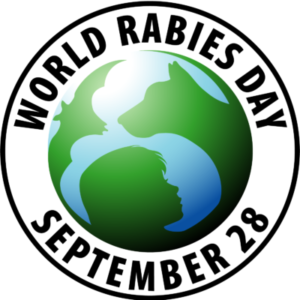
September 28th is an important day in human and animal health. September 28th marks the anniversary of Louis Pasteur’s death. Louis Pasteur was the chemist and microbiologist who developed the first effective rabies vaccine in 1885, used to treat a bite victim. September 28th also marks World Rabies Day, a day to promote awareness and education regarding rabies prevention.
Rabies is a fatal viral disease that can be transmitted from animals to humans and is found in wildlife populations including skunks, raccoons, foxes, bats, and coyotes. Rabies is most commonly transmitted via a bite from a rabid animal but can also be transmitted whenever saliva of an infected animal comes in contact with broken skin (cut, scrape) or mucous membranes (eyes, nose, mouth). Once a person begins to show signs and symptoms of rabies, it’s nearly always deadly.
Many countries have been declared “rabies free”; however, rabies still kills about 60,000 people a year, many of whom are children living in economically depressed countries in Africa and Asia. Most human cases (99%) are acquired through the bite of an infected dog.
The Global Alliance for Rabies Control (GARC) has a goal to achieve zero human deaths from canine rabies by the year 2030. Since 2018, GARC has delivered over 2 million doses of rabies vaccine to countries in Africa and Asia for vaccinating roaming and stray dogs. Through education and awareness programs, community members—especially children—are taught how to avoid being bitten, understand animal behavior, and what to do in case of a bite.
While canine rabies has been eradicated in North America, pets can still get rabies from wildlife. In North America, most cases of rabies occur after exposure to wildlife, but pets can in turn expose humans.
It’s easy to become complacent with the vaccination of dogs – and other pets as well – even when it comes to a disease as dangerous as rabies. Vaccination of our furry companions remains an important part of preventive care.
To protect yourself and your pets from rabies follow these recommendations:
1) Take your pet for regular wellness exams. Your veterinarian will advise you on the recommended vaccination schedule for your pet and ensure that your pet’s plan complies with local laws.
2) Keep your pet away from wildlife, stray, or unfamiliar animals. Do not feed or handle wildlife. Avoid cats and dogs that are unfamiliar to you. Alert local authorities if you encounter wildlife that is overly forward or appears disoriented.
3) Supervise your pets when they are outside, especially at times of day when they are more likely to encounter wildlife (dawn and dusk). Do not keep food or water bowls outside as they can attract wildlife to frequent your yard.
4) Vaccinate your pets—indoor pets too! Rabid animals (especially bats) have been known to enter homes and bite cats.
5) Spay and neuter your pet. By spaying or neutering your pet you reduce the number of stray animals therefore reducing the number of cats and dogs that are in contact with wildlife.
Take a moment today to check that your pet’s vaccinations are up to date. Spread the word about World Rabies Day and do your part to keep your pets and family healthy and safe from the rabies virus.